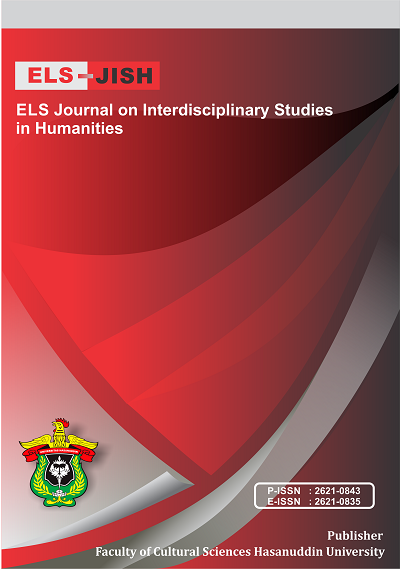Informative Function in the Contents of Preachers’ Sermons in Jayapura Churches
DOI:
https://doi.org/10.34050/elsjish.v5i3.22276Keywords:
GKI Churches, Informative Function, Jayapura, Preachers, SermonsAbstract
Informative function has function to represents one’s understanding of fact and knowledge, to communicate information, and to deliver message. In sermons’ preachers in GKI churches of Jayapura give view that language in theological context can be elaborated with local education/wisdom in Sentani. This study tries to figure out micro function of informative function used by the preacher in educating their congregation. The method used in this study was descriptive qualitative with the technique of recording. The data was transcribed and then reduced. The reduction data then was indexed into table as data displayed. The analysis of data was done based on the elements and features of language used in informative function. The results show that the micro functions of informative function used by the preachers are to give advice, to lecture, to announce, and to give opinion. These micro functions are framed in true values, facts, and historical traces. Further action is also facilitated by the level of acceptance or understanding among the congregations. The acceptance is proved by four elements such as language use, context, point of discussion, and attitude. Fortunately these four elements show the positive respond by the congregations.
References
Andini, C. (2021). The Use of Honorifics in English and Buginese with special Reference to Bone Language: A Comparative Study. International Journal of Innovative Science and Research Technology, 6(7), 873-877.
Aswad, M., Rahman, F., Said, I. M., Hamuddin, B., & Nurchalis, N. F. (2019). A software to increase English learning outcomes: An acceleration model of English as the second language. The Asian EFL Journal, 26(6.2), 157.
Fang, G., Gao, W., & Zhao, D. (2004). Large vocabulary sign language recognition based on fuzzy decision trees. IEEE Transactions on Systems, Man, and Cybernetics-Part A: Systems and Humans, 34(3), 305-314.
Heryanto, G. G. (2019) Literasi Politik. Yogyakarta: IRCiSod. Halm.308. ISBN 978-602-7696-89-1.
Hymes, D. (1972). Toward Etnographies of Communication: The Analysis of Communicative Events. P.Paolo Giglioli (Ed). Language and Social Context. England: Penguin Group.
Jumrad, O. T., & Sari, I. D. M. (2019). Fungsi Komunikasi dalam Organisasi melalui Group Chat Whatsapp Oriflame. Jurnal Common, 3(1), 104-114.
Kabanga’, L., & Paranoan, E. (2021). The Significances of Signs in Local Riddle of Toraja. ELS Journal on Interdisciplinary Studies in Humanities, 4(2), 139-147. Retrieved from https://journal.unhas.ac.id/index.php/jish/article/view/14014.
Kabanga, L., Sobe, M., & Moruk, Y. (2022). Extensive Flouting of Maxim Quantity in Media RRI of Jayapura. ELS Journal on Interdisciplinary Studies in Humanities, 5(2), 209-217. https://doi.org/10.34050/elsjish.v5i2.21300.
Kothari, C. R. (2004). Research Methodology: Method and Techniques. New Age International (P) Limited: New Delhi.
Keraf, G. (1991). Diksi dan Gaya Bahasa. Jakarta: Gramedia Pustaka Utama.
Leech, G.N. (2003). Semantics. Yogyakarta:Pustaka Pelajar.
Lestari, D. (2018). The Representations of Informative Function in Handling Food Service at Restaurant. The 2nd BICSS 2018. https://www.scitepress.org/Papers/2018/99391/99391.pdf
Rahman, F., & Weda, S. (2019). Linguistic deviation and the rhetoric figures in Shakespeare’s selected plays. XLinguage, European Scientific Language Journal, 12(1), 37-52.
Sugiyono. (2010). Metode penelitian pendidikan pendekatan kuantitatif, kualitatif, Bandung: Alfabeta.
Sukmawaty, Rahman, F. F., & Andini, C. (2022). Covid-19 Pandemic and Axiology of Communication: A Study of Linguistic Phenomena. Change, International Journal of Innovative Science and Research Technology, 7(4).1089-1097
Sukmawaty, S., Andini, C., & Rahman, F. F. (2022). The Shift of Honorifics due to The Promotion As A Government Official: Comparative Study. ELS Journal on Interdisciplinary Studies in Humanities, 5(1), 166-176.
Supardi, S. (1993). Populasi dan sampel penelitian. Jurnal Fakultas Hukum UII, 13(17), 100-108.
Weda, S., Atmowardoyo, H., Rahman, F., & Sakti, A. E. F. (2021). Linguistic aspects in intercultural communication (IC) practices at a higher education institution in Indonesia. Eroupean Language Scientific Journal, 14, 2-6.
Wiyanto, M. S. (2020). Using Speech Function on EFL Classroom. English Education: Journal of English Teaching and Research, 5(2), 143-148.
Downloads
Published
Issue
Section
License
Copyright (c) 2022 Lewi Kabanga', Daniel Wenda, Maryo Welly Labobar

This work is licensed under a Creative Commons Attribution-NonCommercial-ShareAlike 4.0 International License.






